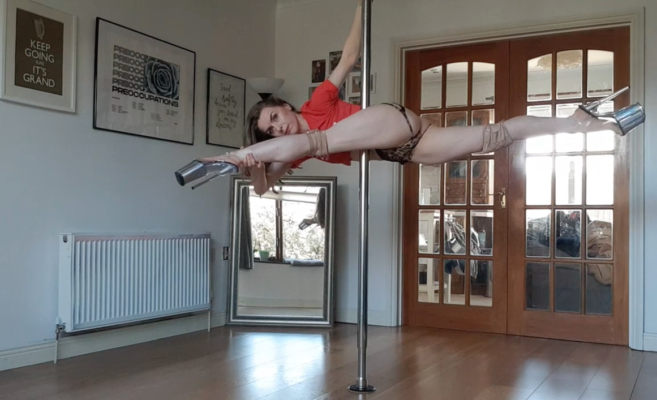
Now that we are all house-bound for what feels like a million years, it’s as good a time as any to invest in a pole so that you can continue your pole dance training at home with our online classes and tutorials.
I’m getting a lot of questions from our members about which pole to buy for home use as well as installation queries, so I’ve put together this handy guide for anyone who is considering buying a dance pole…
‘How much space do I need?’
Obviously the more space you have in your home the better. Sadly most of us don’t have the luxury of having loads of space to dance in. In an ideal world you would have a 2 metre radius of clearance all round from the point where your pole will be installed. I have seen home poles with just over 1 metre clearance all round and this is limiting, but will still work! You won’t be able to do big steparounds and big tricks and spins, but you can still do the basics, as well as plenty of conditioning!
You will also need to check your ceiling height before you buy. There is nothing worse than ordering a pole, the excitement of waiting for it to arrive, assembling it and then realizing it’s too short. A Lupit Pole will extend to 2.8 metres maximum from the box. Extension pieces can be bought separately to increase your pole to a height of 3.3 metres.
If your ceiling is higher than 3.3 metres, you will need a freestanding pole or what’s referred to as a ‘stage pole’. Stage poles are great as you can use them for gigging in large venues (I had one when I was part of The Lovecats Burlesque Troupe) and you can take them outdoors. The disadvantage is that they are pricey, heavy and take up a lot of storage space.
My beloved ‘stage pole’! This pic is from a photoshoot with Jass Foley back in 2010.
You can install your pole on a wooden floor, lino or carpet; it does not affect the installation process greatly. However, you do need a flat ceiling (‘popcorn’ ceilings are not suitable) with a beam. In other words, if you have a ‘fake’ ceiling or a hollow ceiling, this will not support your pole. It needs to have beams running through it. If you are not sure if your ceiling has beams, you can use a device called a stud finder to detect the beams. Or, you can try knocking on your ceiling to find where it is hollow and where the beams are, or you can visually check your ceiling (if you look near to where the ceiling light fittings are, sometimes you can see the lines where the beams are from here).
Choosing a pole part 1:
Second-hand poles
There are lots of poles available to buy from second-hand websites or social media pages. My best advice, avoid buying second-hand unless it’s from a person that you know and trust. Quite often, second-hand poles are ones that are damaged or have pieces missing due to neglect. In some cases, the poles that are for sale are knock-off brands; these are just unsafe and a health hazard. Over the years I’ve seen our students get unlucky with second-hand purchases with pieces missing or poles that don’t spin properly! Buy cheap, buy twice.
Choosing a pole part 2:
Which brand?
There are several brands of dance poles, however the leading brands are currently X-Pole and Lupit Pole. At the time of writing this blog, X-Pole are no longer delivering outside of the UK. So that leaves Lupit Pole as your best choice in getting a pole delivered to Ireland! Lupit Pole are based in Slovenia; in buying their poles you are supporting an EU business.
Going back to my point above, always buy a pole from a trusted brand. Never buy a pole from eBay or a cheap website. If the price is too good to be true, it probably is; there are knock-off poles out there that look like the real brand but at a fraction of the cost. These are simply dangerous and you are putting your life in your hands by buying a cheap product. It’s just not worth it.
Please note that X-Pole are the brand that we have installed in the studio. I have a Lupit Pole myself in my own home, I’ve also used it for Burlesque gigs and I find it is an excellent product! These poles are easy to install and take apart (which is great when you want to be able to put it up and take it down on a regular basis).
I have the Classic Stainless Steel 45mm pole (this is the same diameter and material that we use in the studio).
Click here for the link to the Lupit Pole website! If you are an IPDA Member, you can avail of a discount on all Lupit Pole products. Contact us to avail of the code!
Lovely Lupit Pole! This kit has everything you need for pole dancing at home.
Stainless steel vs. chrome
Stainless steel is a hypoallergenic and higher quality material that is longer lasting. Chrome is a cheaper finish and is a plating. In other words, when you buy steel the entire pole is made of steel and the finish won’t wear off, whereas with chrome it is a surface plating and will wear off eventually with time. If your pole is just for home use, don’t panic, it will take many years of happy poling for the chrome to wear off. You will be grand! However this is why we don’t use chrome poles at the studio, not to mention they are often aggravating for folks who have nickel allergies or skin sensitivities.
Installation
Installing your pole can seem daunting at first, but like many things, once you’ve done it a few times it becomes easy-peasy.
It seems like it doesn’t need to be said, but I’m going to say it anyway. Read the instructions. Fully. You won’t go wrong once you follow the steps.
Putting a pole up is a two-person job, one person to hold it and one person to check whether it is level. If you don’t have a spirit level, you can check if your pole is ‘straight up’ by referencing if it is parallel to other fixtures in your room (usually the walls / corners). You should check this from varying positions to be sure that it’s fully parallel!
Cleaning and taking care of your pole
You will need to treat your pole with care and respect to keep it happy and rust-free.
If you’re buying a stainless steel pole, it only needs water and a tiny bit of alcohol or disinfectant to clean it. Make sure you use a dry cloth to dry it after you clean.
If you’re getting a chrome pole then you will need to be more careful because of the nature of the plating. The best thing to use is an alcohol based solution to clean it. I don’t recommend using strong chemicals and never, ever use window cleaner! I’ve seen folks getting weird rashes and reactions based on whatever products they are using on their poles transferring onto their skin…
Using grip products on your pole
I recommend using ‘pole safe’ grip products on your pole so that you can take care of the finish. Your typical brands such as the Lupit Pole Grip Pads and Dry Hands (that we sell at the studio) are perfect. Avoid weird hacks such as hairspray, candle wax and shaving foam! I’ve tried them, they don’t work very well (it’s why products such as Dry Hands were invented).
When you’re done practicing, make sure to clean off any grip products left on your pole and dry it after you; just like you would when you are at the studio!
Taking your pole down
All poles, whether they get used a little or a lot, need to be taken apart once in a while and checked. This will help to keep it in good condition by ensuring that the parts don’t get ‘stuck’ or fused together.
If you are taking your pole apart to store it away, take it apart fully and ensure that the pole tubes are lying flat. If you don’t take off the ceiling and floor plates, or leave it lying propped up against a wall, the pole tubes can become warped. I have seen this happen and sadly, once the pole is warped it’s impossible to fix and it will never spin properly again. Sad face!
I recommend storing your pole somewhere cool and dry to prevent it from getting tarnished.
My Lupit Pole and I.
Safety first
I could write an entire dissertation on this last point. When training at home you really have to be careful and use common sense when it comes to your own safety.
Always warm up before you train and cool down afterwards (remember I have full warm up and cool down follow along videos available to stream on my Patreon page!). Start with some conditioning movements, because you can never get too good at pull-up crunches, and with some basics such as steparounds, pirouettes and beginner spins to get your pole warmed up and to get your brain in pole dance mode.
When it comes to training tricks, if you’re practicing something that you’re not so sure about have someone at home spot you. Show them a video or photo of what you’re trying to achieve and tell them specifically where to spot you, otherwise they won’t know how to stop you from potentially falling out of the move.
Second point about training tricks, stick with tricks that you actually know how to do or have been taught in class from a professional instructor. I know it’s tempting, but please, please do not attempt a fancy trick that you have seen a random person on Instagram doing! The danger of this is that more often than not, these tricks are made to look easier than they actually are; I see advanced and elite level movements and tricks being wrongly tagged and labelled as ‘beginner level’ all the time. If the trick or pose in question is simply presented as a cool photo, we usually have no idea as to how that person got into it, or out of it! It may not be as safe as it looks. Without having the person there to explain how they are executing the trick with a step by step breakdown with attention to safety details, we are often guessing and putting ourselves at risk of injury. I know it’s tempting to try something out that looks easy, but please use common sense!
Happy poling!
Arlene Caffrey x
